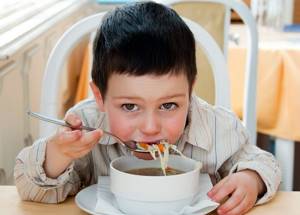Child nutrition is a very sensitive topic that must be approached with the utmost seriousness. We all know the saying: “we are what we eat.” So children are a blank slate on which you yourself write down food norms and rules. What kind of nutrition will you teach your child, what kind of eating behavior will you instill, what attitudes about food will you give, and with this baggage he will go into adulthood.
This is why it is so important to set your children the right example in food management from early childhood. And today I would like to consider such a popular topic as nutrition for schoolchildren. Wellness Consulting Academy experts often face the question of how best to feed a schoolchild so that he can easily cope with mental stress at school and physical activity during sports training. Well, let's answer this question...
Breakfast is a must
Even if your child has an organized breakfast at school, this does not replace eating at home. Any pediatric nutritionist will tell you that breakfast should be no later than 2 hours after waking up. That is, the child wakes up, drinks water to start the work of the whole body, does exercises, washes his face, then eats and gets ready for school.
If he waits for breakfast at school, then by that time he will be very hungry, and the body without morning nutrition will simply slow down its metabolism (the nutrition system for younger schoolchildren involves an organized breakfast, usually after the first lesson).
Don't know what to feed your schoolchild for breakfast? Give him porridge with fruit or an egg dish with vegetables - this option is perfect for those who do not eat well at school and do not like school lunches. If your child does not experience difficulties with table meals, then in the morning you can give him low-fat natural yogurt, which will allow him to calmly wait for the planned breakfast at school.
Remember that the morning meal must charge children with energy, since they have mental work and an active day ahead of them. Therefore, it is better to feed a schoolchild complex carbohydrates, which can be combined with light proteins. Whole grain bread with cheese, egg dishes, porridge (with fruit or dried fruit), vegetables, cottage cheese casserole, cheesecakes, etc. are suitable.
Ideal lunch and dinner for children
Lunch for children begins with vegetable salads, followed by soups. Children under three years of age should not be fed meat broths; vegetarian soups are more suitable for them. And for older children, it is better to alternate first courses of meat products during the week with:
- dairy
- fruity
- and vegetable soups.
Meat soups for children should be cooked only in a second broth made from lean meat. When cooking, when the water boils and all the foam comes to the surface, remove it from the pan with a fork.
By the way, the amount of foam indicates the quality of the meat: it is especially abundant when the meat is old or frozen. You need to pour out the first broth and wash the pan after it, then add water to the meat again and cook until done.
The second lunch course should include protein foods:
- meat
- or fish.
It is better to boil both of them and then, if desired, fry them. Let the side dishes be combined and, if possible, different every day.
Fresh fruits and berries should be present in the child’s diet every day
Fresh or boiled vegetables and herbs are added to them. Potatoes should make up only 50% of all vegetables in a child’s menu. The rest is beets, carrots, onions, legumes, leafy vegetables, melons, and of course garlic.
The child must definitely eat cabbage - the “queen of vegetables.” Due to the coarse fiber it contains, it remarkably cleanses the body and gives it a huge range of vitamins. You can give your child both raw and sauerkraut in any quantity. If gases accumulate from raw meat, then it must be scalded with boiling water or extinguished.
Between lunch and dinner, children should have an afternoon snack, during which they can eat cottage cheese, drink kefir or yogurt, or give them yogurt. Cottage cheese is a concentrated source of easily digestible proteins, and children should receive at least 50 grams of it daily. It’s good to “bundle” fermented milk products with a piece of biscuit for an afternoon snack. Then you can give them fruit.
For dinner, children should not be fed meat food, which has a stimulating effect. In the evening, a vinaigrette or salad is best. It’s also a good idea to make a stew from any vegetables.
Meet your daily calorie needs
A child’s diet, regardless of age, should be clearly regulated in terms of calorie content. In the table below you will find the daily calorie intake for different ages:
Children
| 5 - 6 years | 1990 kcal |
| 7 – 10 years | 2380 kcal |
| 11 – 13 years | 2860 kcal |
| Boys 14 - 17 years old | 3160 kcal |
| Girls 14 - 17 years old | 2760 kcal |
Please note that these are general indicators that are calculated for a child with average parameters in terms of height, weight and physical activity. If you want to understand how many calories your child personally needs daily, it is better to consult a pediatric nutritionist. He will make calculations based on the specific parameters and lifestyle of your student.
You can simplify the task - become your own nutritionist for your child. The Wellness Consulting Academy has a separate proprietary course in this area (we generally have many different courses - take a look
).
Try to comply with the daily norm of the energy value of the diet. If a child overeats, sooner or later he will face a problem such as childhood obesity. It develops quite quickly with regular excess of caloric intake, incorrect eating habits, and infatuation with unhealthy foods such as fast food, snacks, and sweets.
Do everything possible so that your child does not learn what excess weight is, because losing weight is quite difficult for children - harder than for adults, who can use willpower and motivation.
You should not allow malnutrition, when your daily calorie intake is noticeably below normal. With insufficient nutrition and energy deficiency, the child will quickly get tired, he will have difficulties in learning due to problems with concentration, and the level of physical activity will decrease due to lack of strength. Always monitor how much your children eat.
Noticed problems with your appetite? Try to find out what's wrong. Perhaps the child does not like what you offer him on the menu, he does not feel well, his throat or teeth hurt, or stomatitis has developed in his mouth. Be sure to check whether he has enough sweets to suppress his appetite, whether he has enough physical activity, whether he is under stress, or whether he has eating disorders (for example, prerequisites for the development of anorexia).
Proper nutrition for children is the key to health
Antonina Shepotko
Proper nutrition for children is the key to health
Proper nutrition for children is the key to health
Among the many different factors that constantly affect the development of a child’s body and its health nutrition plays the most important role . Nutrition in early childhood leaves an imprint and influences the further development of the child and his health not only in childhood, but also in adulthood.
Proper or rational nutrition is a diet that ensures the strengthening and improvement of health , physical and spiritual strength of a person, the prevention and treatment of diseases. In a word, proper nutrition is healthy eating . Rational nutrition is a necessary condition for the harmonious growth, physical and neuropsychic development of a child, resistance to infections and other adverse environmental factors.
Most preschoolers attend kindergarten, where they receive age-appropriate meals . Therefore, the home diet should complement, and not replace, the kindergarten diet. For this purpose, teachers post the daily menu in each group so that parents can familiarize themselves with it. Therefore, at home it is important to give the child exactly those foods and dishes that he did not receive during the day.
The nutrition of preschool children should take into account the characteristics of their digestive system, which has not yet become stronger and formed. The child's diet should consist of easily digestible components.
In order for a child to grow healthy and strong , have good immunity and actively develop, both physically and mentally, a number of basic principles of diet must be observed:
— compliance with the requirement to obtain the required amount of energy from food, which is required for mental and physical activity;
— variety in a child’s diet is one of the main factors in its balance. In addition, it is necessary to take into account the individual characteristics of the child’s body, and also remember about possible intolerance to certain foods ;
— food must provide the child’s body with all the necessary nutrients ;
- compliance with the technology of food processing, as well as food preparation, compliance with sanitary standards in the premises where food is prepared, the use of only fresh products without an expired expiration date - these requirements can also be attributed to the features of preparing a diet for preschool children .
The amount of energy obtained from food is measured in calories, but its value lies not only in this: the composition of the food is also important. Carbohydrates, fats and proteins, minerals, water - all this is required for “construction”
cells and bone tissue.
Proteins are of particular importance, since without them the basic elements of organs and tissues cannot be built. They cannot be replaced by other nutrients. Lack of protein in a child's diet not only slows down normal growth and development, but also affects brain function and the functioning of the body's immune system.
Fats are a source of energy, take part in metabolism, and contribute to the development of immunity.
Carbohydrates are the main source of energy and promote the absorption of proteins and fats in the body. Excessive amounts of carbohydrates lead to metabolic disorders.
Mineral salts and trace elements are building materials for organs, tissues, cells and their components. Ensuring their intake into the body is especially important during the period of active growth and development of the child.
Vitamins - your daily diet should contain sufficient amounts of all vitamins. Vitamins are necessary for the normal course of biochemical reactions in the body, absorption of nutrients, growth and restoration of cells and tissues
Water is of great importance in the diet , since life processes cannot occur without it. A child needs about one and a half liters of water per day.
Proper nutrition for preschool children is a source of energy and a cure for many diseases. If you really want your child to have good health , to be beautiful, physically and spiritually active, harmoniously developed, and with good immunity, then proper nutrition should be the basis in his life. Properly organized nutrition for preschool children is one of the main tasks of kindergartens and parents.
The diet creates the best conditions for the absorption of food. Failure to comply with the regime leads to loss of appetite and a decrease in the secretion of digestive juices.
The full development of the child’s body - in many ways, health depends on how well the diet is prepared .
The nutrition of a preschool child should be:
- complete, containing proteins, fats, carbohydrates, minerals, vitamins, water in the required quantities;
- varied, consisting of products of plant and animal origin. The more diverse the set of products included in the menu, the more fully the need for food is satisfied;
- benign - do not contain harmful impurities and pathogenic microbes. Food should not only be tasty, but also safe. You should limit your consumption of foods and dishes high in salt, sugar and spices.
- sufficient in volume and calorie content to cause a feeling of satiety. The nutrition a preschooler receives must not only cover the energy he expends, but also provide the material necessary for the growth and development of the body.
Thus, proper nutrition is not a diet or strictness towards the child’s body, but a norm, which, having mastered, the child will be healthy .
Literature
1. Galaeva G., Klimova Y. “Talk about proper nutrition ” // Hoop - No. 5, 2002.
2. Druzhinina L. nutrition in kindergarten and at home // Preschool education . –№6, 1998
3. Makhoneva M. “ Raising a healthy child ” // Preschool education No. 6 , 2002.
Establish an adequate diet

For children, a split diet with meals 5-6 times a day is optimal. This will allow them not to experience a strong feeling of hunger, which means they will not overeat, and will also help maintain normal blood sugar levels, which is important when schoolchildren have increased mental stress.
The break between meals should be about 3 hours. There should be 3 main meals and 2-3 healthy snacks per day.
The mode might be something like this:
- 7:30-8:00 – breakfast at home;
- 9:30-10:00 – second breakfast (snack) at school;
- 13:00-13:30 – lunch at school (if the child goes to after-school or many lessons) or at home;
- 16:30-17:00 – snack at home or at school after school;
- 19:00 – dinner at home;
- 21:00 – you can have a low-calorie snack before bed (give a glass of low-fat kefir or unsweetened natural yogurt).
Baby's diet and menu at one year old
At the table with the family - this will be the second year of the baby’s life. It doesn't matter whether he eats with a spoon or with his hand. The main thing for a 1-year-old child is to choose the right foods, consolidate the first eating habits and form a diet. We have compiled for you a list of products for five meals with vegetables, grains and meat that will provide your baby with energy reserves and nutrients. And they also asked about sweets... Nutritionist, member of RoSNDP Anastasia Ivanovna Shalunova tells.
— Anastasia Ivanovna, is the menu for a 1-year-old child already food from the common table or a special children’s menu? Is it possible to give a child adult food?
— For a one-year-old child, adult food can be heavy and not always digested correctly. Therefore, the task of parents is to give their baby a lighter version of the same food (try not to overuse salt, seasonings) and the most natural products possible.
Different countries have their own specifics of baby food. For example, in France, children eat the same as adults, who try to eat the right foods. Children quickly get used to the general menu and do not run out from the table if they are full faster than others. In Russian families they cook separately for adults and children. And for mom it’s a “brain explosion” to create different dishes for family members. Therefore, it is easier to cook something average that both adults and children can eat.
— What actions of parents can disrupt the diet in one year?
— Every family has a certain list of products that are in the refrigerator, and the child knows about them. Parents mistakenly, on a whim, continue to buy the same thing, while it is necessary to diversify the diet, more often try seasonal, inexpensive, but healthier products. In addition, it is important that by the age of one year the child sits at the table and understands how they eat, and also that he came to eat and not to play or watch TV.
Basic principles of nutrition at 1 year
- Stick to a regimen of three main meals and two snacks.
- Use foods of accessible consistency and form of preparation.
- Introduce all the food groups that the child should have tried by his age to make it easier to build a diet.
- Do not feed the child.
- Give your baby clean drinking water every day.
— What to feed a child per year so that he receives all the nutrients necessary for his age?
- Vegetables - selected according to age, should occupy half the plate.
- Fruits are given after vegetables because they are sweeter.
- Porridge is the main source of vitamins and minerals and calories.
- Cottage cheese and yogurt without sweeteners are sources of calcium, which is necessary for growth.
- Soups - not all children eat them because of the consistency, but you can try natural vegetable cream soups from the baby food group.
- Meat is a source of protein and vitamins. If the family refuses meat, then the child will have to make up for the lack with something, for example, vitamin B12.
- Natural sweets and cookies - but they must be “tested”. It is necessary to avoid products with the addition of margarine and trans fats, which will negatively affect the child’s body.
After one year of age, a child’s diet should be varied and balanced in microelements and vitamins, proteins, fats and carbohydrates. A large amount of fiber is useful for the proper formation of microflora - dietary fiber helps maintain a balance of beneficial and opportunistic bacteria in the body.
— Is it possible to include solid foods in the menu if the baby has only cut a couple of teeth?
“Solid foods help develop good eating habits and are very good for your teeth.” Hard pieces form the correct bite. The more such food in the diet, the more space there will be in the oral cavity and the straighter the teeth will grow. As a nutritionist, I recommend giving solid foods to help teeth erupt faster. Orthodontists take the same position.
— What foods should not be given to a one-year-old child?
— It is worth limiting fatty foods rich in cholesterol, as well as nuts, which can provoke an allergic reaction or enter the respiratory tract. Doctors also do not recommend giving mushrooms - they contain difficult-to-digest protein, which increases the load on the enzymatic system. You should not burden the gastrointestinal tract; it is better to simply exclude such foods from your diet.
— Among the infant formulas you can find a third-stage formula for children over 12 months. What are the benefits of “baby milk” for older babies?
— Special infant milk formulas are needed if the child is not yet fully fed from the common table or the mother supplements him with formula at night. The third stage mixture, unlike regular milk, contains all the components necessary for the formation of mental abilities in children, that is, it is aimed not just at growth, but also at brain development. If parents are interested in ensuring that the child receives vitamins and minerals in a balanced form, it is advisable to turn to a milk formula, for example, a mixture with the MAMAKO Premium® IQ complex. The baby can be fed a limited range of foods, and the mother often worries whether he is getting all the necessary vitamins and minerals. The mixture is very helpful during this period.
— When creating a menu for a week for a 1-year-old child, what points need to be taken into account? What determines the correct diet for one year?
— When compiling the menu, the presence or absence of allergic reactions, taste preferences, age and health status of the baby are taken into account.
- Breakfast
— For the first meal, it is better to give porridge (long-term carbohydrates) or a protein product (omelet). The baby needs to start the morning actively, and this requires energy, which is replenished during feeding.
- Dinner
- In the second main meal, you can only have vegetables or a protein product, since the child still needs to actively express himself for half a day. In sports families with the most active children, protein foods must be eaten during the day. Protein is a building material that is necessary for muscle and cell growth. You can supplement your diet with healthy vegetable cream soup, for example, pumpkin or spinach, and you need less carbohydrates.
- Dinner
— In the evening, it is advisable not to overload the body. You can give porridge 1.5-2 hours before bedtime or vegetables, steamed fish cutlets - here the mother adapts to the child’s preferences. Vegetable or fruit purees, supplemented with cottage cheese, diversify the diet. But you don’t need to go to bed immediately after feeding, as the body needs time to digest.
- Snacks
“They break two large “windows” between breakfast and lunch, lunch and dinner. Which foods to choose for a snack depend on the age and well-being of the child.
— Anastasia Ivanovna, is it necessary to put the child to take a nap after each meal?
— After feeding, the child subconsciously has a craving for sleep, but this is not a rule that should be followed. If the baby has no strength - he ran around on the street, played non-stop for 1.5 hours, then ate - yes, he needs to replenish his strength and he will fall asleep. In general, eating is a replenishment of energy costs, and after eating it’s good to give up some of the energy - move around, leaf through a book.
— Is it necessary to wean a child from night feedings if he wakes up at night and asks for food?
- The norm after a year is to sleep without waking up. The child may wake up in a hot room, ask for a drink and sleep until the morning. But a child who wakes up is always a wake-up call for the mother. The baby’s anxiety may have physiological or psychological implications - something hurts, he is afraid of something, he is malnourished. Everything is tested empirically - the next day, feed the child more heavily before bed. If he sleeps, it means he was just hungry yesterday. If it continues to wake up, then use the method of elimination to further figure out other reasons.
— If the diet at 1 year is not followed and the child refuses the family table, should he be forced to eat?
“There’s definitely no need to force-feed, but we follow the regime.” The child must form the habit of eating at the table with his family. Ideally, during breakfast, lunch and dinner, but at least one meal should be a family meal.
If a child has tried the proposed product and does not want to eat it, he must understand that the next meal is not soon and, for example, he will have to drink water until the morning. The child must be clearly aware of the actions and words of his parents. All good habits are established in early childhood.
The basic rule is that only those products appear in the house that parents want to see on the child’s menu.
— Are fruit purees with goat’s milk curd suitable for feeding one-year-old children? Is it possible to give a child puree instead of fruit if he does not want to eat it?
— Children's products labeled from 0 to 3 years old, of course, can be given. But ordinary “adult” cottage cheese in the diet of a one-year-old child can cause a negative reaction in the body.
Children's fruit purees with goat's milk curd are balanced and can replace fruit - such purees are offered by MAMAKO®.
A one-year-old child’s diet can include all products of natural origin and seasonal local products. You should not feed your baby very salty, canned or fried foods. At the same time, it is important to avoid one-sided nutrition, but you should select foods according to age so as not to provoke an allergic reaction and digestive disorders.
Nutritionist Anastasia Ivanovna Shalunova
*The ideal food for an infant is mother's milk. WHO recommends exclusive breastfeeding for the first 6 months. MAMAKO® supports this recommendation. Before introducing new foods into your baby’s diet, consult a specialist.
Make your diet balanced
Children, first of all, should eat as varied a diet as possible. This is the key to their good appetite and good health. A balanced diet will fill the child’s body with all the vitamins and minerals, and will also provide the necessary nutrients.
The school menu is developed by children's nutritionists; it complies with the approved norms and rules. So you don’t have to worry too much about hot meals for schoolchildren - the main thing is that the school cooks follow all the requirements.
At home, you will have to create a menu for your child yourself. Focus on the following BZHU ratio (we gave the daily calorie intake above):
| Name of nutrients | Average nutrient requirements | |
| 7-11 years | from 11 and older | |
| Proteins (g) | 77 | 90 |
| Carbohydrates (g) | 335 | 383 |
| Fat (g) | 79 | 92 |
The child's diet should include vegetables, berries and fruits, whole grain cereals, wholemeal bread and pasta, lean meat, fish, seafood, legumes, eggs, dairy and fermented milk products.
As a snack, give to school washed fruits and cut into pieces fresh vegetables, whole grain breads, sandwiches with healthy filling (for example, with low-fat cheese and vegetables), granola, natural crackers or other high-quality cookies, nuts, dried fruits.
If your child has intense mental work planned, for example, a test, an oral report, a laboratory, then you can give him a strip of dark chocolate with him. It contains little sugar, but it helps to stimulate mental activity (provided that the child is not allergic to chocolate and has no prerequisites for the development of diabetes mellitus or has already been diagnosed).
Make sure that all nutrients are in sufficient quantities on the student’s menu. Children need protein for active growth, building muscle mass, building new cells and developing internal organs, as well as strengthening the immune system.
Carbohydrates provide children with energy for active mental activity and increased physical activity, giving them a good mood and vigor. The right fats are involved in the development of the hormonal system and internal organs, take care of the beauty of hair and skin, help withstand intellectual stress, and ensure good memory.
This is why it is very important that your child receives plenty of Omega-3 fatty acids throughout the school year. You can find them in fatty fish, seafood, nuts, unrefined vegetable oils, avocados, flax seeds, sesame seeds, sunflower seeds, etc. If your student does not particularly like the listed category of products, then give him Omega-3 in the form of supplements or as part of complex vitamins.
We monitor what our children drink
Parents should pay attention to what children drink and in what quantities. Our market is flooded:
- sprites
- cola
- Pepsi
and other drinks. Moreover, they are sold in containers of 1.5 and 2 liters, and children often drink a whole bottle a day. Contents in these drinks:
- sweeteners
- dyes
- preservatives
allowed by GOST, but with limited consumption, no more than two hundred grams, and in large quantities they are extremely harmful to children.
Industrially prepared juices are mostly diluted concentrates. Even if the package says: 100% natural juice, it most likely is not. These drinks, as a rule, contain substances that are undesirable, especially for children under three years of age. Therefore, it is better to give them freshly prepared juices, and from ready-made juices, specialized ones intended for children in their first year of life.
Freshly squeezed orange juice is very useful for children, unless, of course, there is an allergic reaction to it. Compotes made from dried fruits or fresh berries and fruits are good. Moreover, you should not add sugar or any substitutes to them.
The child must definitely eat cabbage - the “queen of vegetables.” Due to the coarse fiber it contains, it remarkably cleanses the body and gives it a huge range of vitamins.
It’s better to make the compote more concentrated, in which case it will still be tasty. A drink made from cranberries, which is rightfully considered the “queen of berries,” is generally invaluable in its qualities.
Cranberries cleanse the body well and contain a lot of useful substances. To prevent them from disappearing during cooking, you need to squeeze out the juice, pour it into a jar, close it tightly and place it in the cold. Boil the peel and remaining pulp in water, strain, and add juice to the cooled drink.
As for whole milk, children after one year are not required to drink it. It is enough if they get it in cereals or purees. Fermented milk products are much healthier for children; they contain the microflora necessary for the body. At an early age, children need up to 600-800 ml of milk daily in sour and unleavened form, and after three years - up to half a liter.
Stick to your daily food intake
In addition to the calorie content and ratio of BZHU, there is also such a thing as the daily requirement for certain products. For example, every day a student should eat:
- approximately 2-4 fruits (about 200 g);
- 3-5 fresh vegetables and herbs (at least 350-400 g in total);
- 250 g potatoes;
- 95-105 g of meat or 60-80 g of fish;
- 50 g cottage cheese;
- 50 g of cereals or legumes (dry);
- 100-150 g of whole grain bread or crispbread;
- 500 ml of dairy and fermented milk products;
- 1 egg.
Permitted and required products
A child’s body at 7 years old needs nutrients from 5 groups:
- proteins (norm – 80 g per day, of which 48 g are animal proteins);
- fats (norm – 75-80 g per day);
- carbohydrates (norm – 300-350 g per day);
- vitamins;
- minerals (calcium, iodine, iron, phosphorus, magnesium, and others).
Proteins (proteins) are the main building materials for body cells. Proteins are associated with: growth, metabolism, muscle contractility, transmission of impulses along nerve fibers, formation of immunity. It is especially important to consume proteins in childhood, and both plant and animal sources are needed, as well as dairy products.
Nowadays, the phenomenon of vegetarianism, which advocates a complete rejection of animal proteins, has become popular. But healthy baby food must include this component, and its exclusion or limitation is unacceptable. A lack of animal food is fraught with pathologies in the mental and physical development of a child.

Photo: depositphotos.com. Author: pavsie.
Protein foods should be included in the diet of a seven-year-old child on a regular basis. These include:
- lean meat;
- sea and river fish;
- milk – up to 500 ml per day;
- dairy products;
- cottage cheese, daily volume – 40-50 g;
- cheese;
- legumes: beans, peas, lentils;
- nuts: walnuts, hazelnuts, peanuts, cashews;
- eggs.
Fats are part of every cell in our body. They, like proteins, can be plant or animal. Animal fats are rich in vitamins A and D, while vegetable fats are rich in vitamin E.
The diet of a primary school student must include both types of fats. In this case, the volume of animals should ideally be 2 times the volume of plants.
Foods rich in fats:
- various unrefined vegetable oils: sunflower, soybean, olive, corn, etc.;
- nuts: Brazilian, cashew, walnut;
- fatty fish: herring, salmon, chum salmon, pink salmon, etc.;
- cream;
- sour cream;
- cheese;
- butter.
Carbohydrates are the main supplier of energy for a growing body. It is desirable that the need for carbohydrates in children 7 years of age be covered mainly by including cereals and cereals in the children's menu. These are sources of “slow” carbohydrates that supply energy to the body for a long time. But the volume of “fast” carbohydrates (cakes, cakes, sweets) should be no more than 10-20% of the total volume per day.
Foods rich in carbohydrates:
- cereals, cereals: buckwheat, rolled oats, corn, barley, pearl barley, rice, etc.;
- legumes: peas, beans, chickpeas;
- durum wheat pasta;
- dried fruits: dried apricots, raisins, prunes;
- corn;
- potatoes, zucchini, pumpkin;
- bananas;
- bread products made from wholemeal flour;
- jam, honey, jams, marmalade.
Vitamins and minerals must be supplied to the child with food. The main sources of minerals and vitamins are:
- fruits (required volume – 300 g per day);
- vegetables (volume – 280 g per day);
- berries and greens;
- milk and dairy products;
- meat and fish;
- cereals.
The basic principle of preventing a lack of minerals and vitamins in children 7 years old is a varied children's menu.
Particular importance should be given to the drinking regime of a 7-year-old child. The total volume of water that he should consume per day is 50-70 ml per 1 kg of weight, that is, approximately 1400-1500 ml.
The required volume is achieved through the consumption of soups, drinks (tea, cocoa, milk, juices, compotes, fruit drinks) and clean drinking water.
At what age can a child be given cocoa?
Remove all unhealthy foods and drinks from your child’s diet.

According to the standards of pediatric nutrition, a child can eat only 20-25 g of sweets and 5 g of salt per day. This means that all over-salted foods and dishes are prohibited for him. This includes chips, salted crackers and nuts, other salty snacks, pickles and marinades, and store-bought sauces.
As for sweets, 20 g will only satisfy a couple of sweets, a few cookies or a strip of chocolate. However, you can dilute a schoolchild’s healthy diet with natural sweets, for example, fruit marmalade and sugar-free marshmallows, homemade jelly or pudding, cookies without margarine with stevia, and cereal bars without sweeteners.
Also, do everything possible to prevent your child from drinking sugary carbonated drinks, energy drinks, or getting carried away with store-bought juices (they also contain a lot of sugar). Serious restrictions apply to all sausages, fast food, fatty meats, fast food, which contain a lot of trans fats, harmful food additives, and salt.
Cook in a gentle way
The food of children who study should not only be healthy and balanced, but also properly prepared. A lot really depends on the cooking method. First of all, whether the product will become harmful, and how many vitamins and minerals will be retained in it.
This is why frying in oil and deep-frying are not suitable options for children's kitchens. By absorbing a lot of oil, the dish becomes fatty and higher in calories, and if the technology was violated during frying, the product is also saturated with trans fats.
It is best to boil, steam, stew without oil, grill, bake in the oven, cook in a slow cooker. These methods are completely safe and will not harm the children's gastrointestinal tract.
Adjust the student’s nutrition according to training calculations
If, in addition to school classes, a child attends some other sports sections, then his diet needs to be adjusted taking into account training. When thinking about what to feed a schoolchild who has a lot of physical activity, remember that little athletes need more protein and complex carbohydrates.
Proteins will ensure normal muscle growth and proper recovery after exercise, and carbohydrates will provide energy and strength for training. You cannot eat before training; your last meal should be 1.5-2 hours before training.
After training, you can eat within half an hour, and if the child is hungry, then let him snack on something healthy right in the locker room. It could be a fruit, a cereal bar, or nuts. The diet of athletes should be rich in vitamins and minerals. If a child does not like a particular category of foods, then his diet must be enriched with vitamin and mineral complexes.









